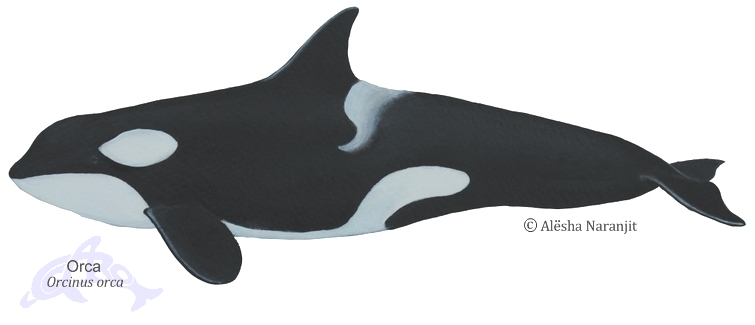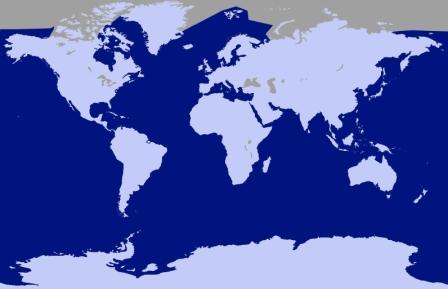Orcinus orca

Classification Other Names: Killer Whale, Grampus Suborder: Odontoceti Family: Delphinidae | Description Orca are powerful swimmers and often surface active. They are inquisitive and do approach boats but rarely bowride. They form stable social groups which tend to have different prey species, hunting techniques and vocal dialects that they teach to their young.
|
Orca Ecology Range: May occur in any marine and some esturine habitats from the equator to the poles. Thought to be the widest ranging mammals species after humans. Usual Habitat: Commonly occur in areas of high marine productivity. Usual group size: Mammal eating groups tend to be smaller with 5-10 individuals but fish eating groups often have 20-200 individuals. Main Diet: As a species they prey a wide range of animals including marine mammals, birds, sea turtles, fish and cephalopods but some populations of killer whales specialize on particular types of prey species. They also employ a wide range of hunting techniques Local population: Unknown | Global range of the Orca  The dark blue areas indicate where Orca are likely to be found |
Protection and Conservation Status
IUCN Conservation Status: Orca are listed as "Data Deficient" on the IUCN red list. SPAW Protocol: Orca are cetaceans, which are listed under Annex II of the SPAW protocol. As such they require total protection under article 11 of this protocol which prohibits the "taking, possession, killing and commercial trade of the species, their parts or products". The SPAW protocol was created to help with the implementation and promotion of the Ramsar Convention and the Convention on Biological Diversity. The Annexes of the SPAW protocol can be found here. Local Laws: Cetaceans are protected under the Conservation of Wildlife Act of Trinidad and Tobago which offers protection to all species not listed under the second or third schedules of this act. |
This is currently being researched and written. It will appear here shortly.
References
The above information was obtained from the following sources:
- A Princeton Field Guide: Whales Dolphins and Other Marine Mammals of the World by Hadoram Shirihai and Brett Jarrett (2006)
- Smithsonian Handbooks: Whales Dolphins and Porpoises by Mark Carwardine and illustrated by Martin Camm (2002)
- The Whale and Dolphin Conservation Society's Species Guide at http://www2.wdcs.org/species/index.php
- The IUCN Redlist at http://www.iucnredlist.org
- The SPAW protocol Annexes with links available at http://www.car-spaw-rac.org/?Annexes-of-the-SPAW-Protocol,83
Acknowledgements
We would like to thank the following people for the use of the art work and photographs:
- Alësha Naranjit (Illustration of Orca)